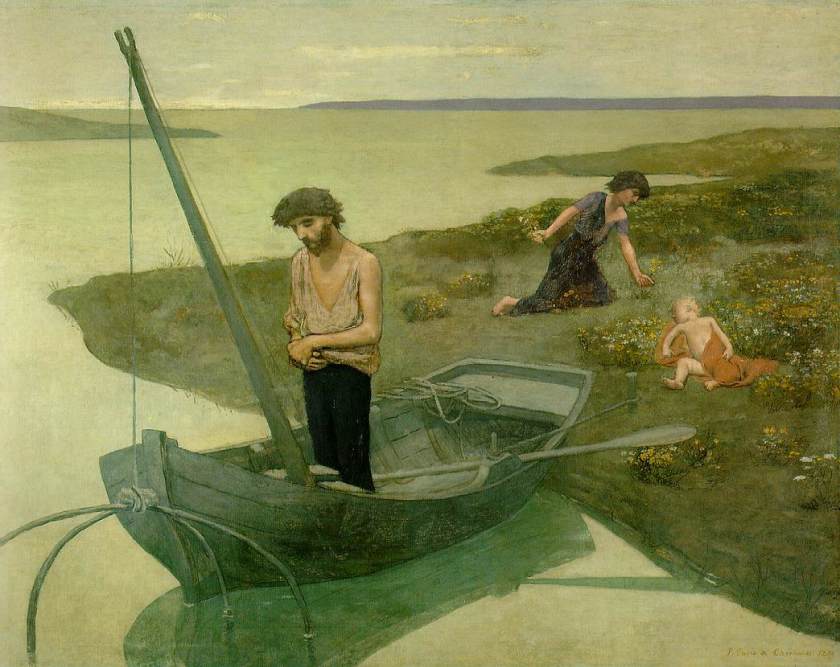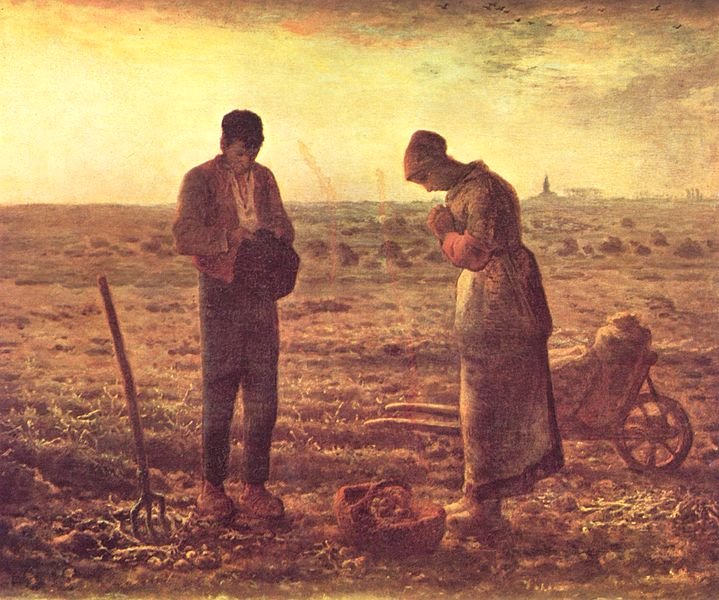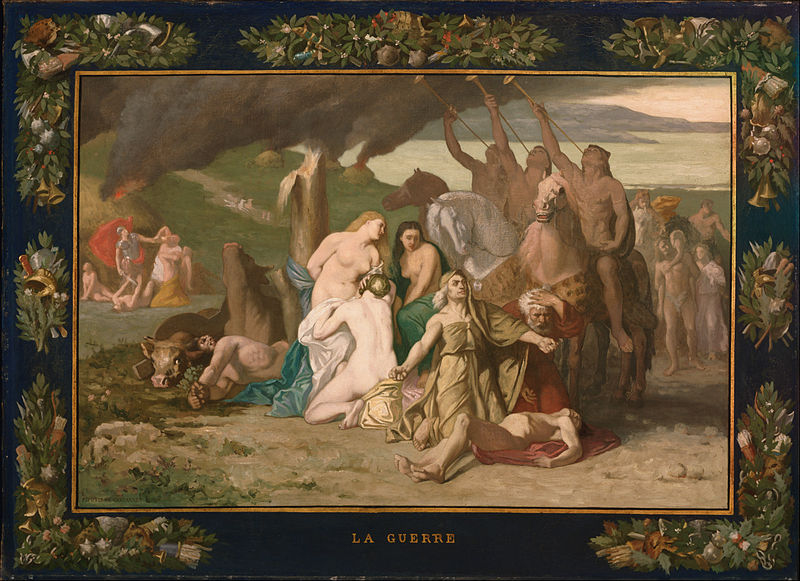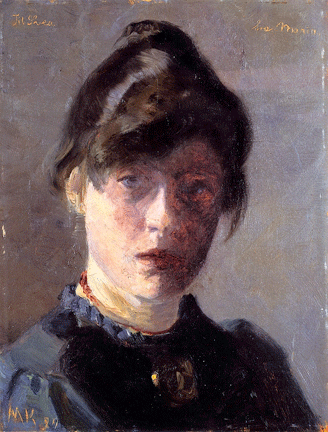
My last blog looked at the early life of Pierre Puvis de Chavannes as well as feature a series of four large wall paintings he completed in the 1860’s. In today’s blog I will conclude his life story and feature one of his best known paintings entitled The Poor Fisherman.
Following the success of his wall paintings for the Musée de Picardie he went on to complete many other wall painting commissions, such as the staircase of the Hôtel de Ville at Poitiers. In 1874 the Department of Fine Arts in Paris commissioned him to paint a number of wall paintings depicting the childhood and education of St Geneviève, the patroness of Paris, for the church of Saint Genevieve, which is now the Pantheon. Puvis procured a second commission for work in the Pantheon in 1896, depicting Genevieve’s accomplishments in old age which consisted of a single composition coupled with a triad of panels, the whole of which surmounted by a frieze.
One of his largest commissions came in 1891 when Charles Follen McKim a partner in the architect firm of McKim, Mead and White, who had designed the new Boston library, went to Paris and approached Pierre Puvis to provide wall paintings for the grand staircase and loggia of their new building. Puvis agreed to carry out this extensive commission despite being sixty-seven years of age. Then Puvis had a change of heart when he accepted a commission for work in the Paris City Hall and so the following year, 1892, the Americans had to send over another representative to Paris to ask Puvis not to renege on his original agreement. After prolonged negotiations in July 1893 Puvis put pen to paper and the contract for the wall paintings was finalised, agreeing to pay the artist the sum of two hundred and fifty thousand francs. Puvis completed his Paris City Hall commission in 1894 and in 1895 he began on the paintings which were to adorn the walls of the Boston Library. To ensure that the wall paintings blended in with the internal architecture the architects sent Puvis samples of the marble which was to be used for the staircase and its surroundings. Puvis worked on the wall paintings at a purpose built studio at Neuilly, just outside of Paris and completed them in 1898. They were then shipped out to America. Puvis never saw for himself his paintings in situ in the Boston library. For a much more detailed account of this commission it is worth having a look at:
http://cool.conservation-us.org/jaic/articles/jaic36-01-005.html
Pierre Puvis did not exclusively work on large-scale wall paintings, he would often relax by carrying out smaller easel paintings and today I am featuring one such work which he completed in 1881 and entitled The Poor Fisherman, which is housed in the Musée d’Orsay. Although not the size of one of his wall paintings, it is still a large work, measuring 155 x 192 cms.

In the painting we see a forlorn-looking man, head bent, standing up in his boat with his hands clasped together in front of him as if in prayer and it is his stance along with the connection between Christ and his Apostles and fishermen, which gives the painting a somewhat religious feel to it. Is he praying for success in his forthcoming fishing expedition or as some would have us believe it could be that it was noon and, as a practicing Catholic, the fisherman was reciting an Angelus prayer. This supposition is based on the similar stance of the figures seen in Millet’s 1859 The Angelus painting. On the bank there is a woman, his daughter, collecting flowers and his sleeping baby, lying on his back in a bed of wild flowers. One is struck by the bleak landscape and the contrast between the seemingly happy female as she picks the flowers, the peacefully sleeping child with the troubled poverty-stricken fisherman as he bows his head down in silent contemplation.
The work was exhibited at the Paris Salon in 1881 and received a mixed reception and was not sold until 1887 when the French State purchased the work whilst it was on show at the French art dealer, Durand-Ruel’s showroom. So what is there not to like about the work? Is it just too depressing? Does it fail to conform to the artistic norm? In an article in the December 1916 issue of the The Art World magazine entitled “A Trivial Work of Art: The Poor Fisherman by Puvis de Chavannes, the art critic Petronius Arbiter summed up the painting:
“…It is an absolutely trivial work; and, coming from him, was a complete surprise and much criticized at the time. In the first place the lines of the composition are so zigzag that the work is irritating instead of soothing to the eyes. Then the sprawling of the badly drawn child over a low shrub, every leaf and branch of which would prick out of it all sense of sleep or even of comfort, is absurd. Then the head of the mother is too large, and the hair that of a man rather than that of a woman. Then the man looks ‘sawed-off,’ for he is represented as standing with his knees against a seat in the boat. But where is the rest of his lower legs? The boat is either not deep enough or his lower legs are abnormally short, or sawed-off. This is also manifestly absurd. Then the head is so childishly constructed as to be ridiculous. Moreover, what is he doing – praying, fishing, philosophizing over his destiny, or what? The whole thing is childish to a degree. Here we have a meaningless ‘individuality’ with a vengeance…”
However the article’s author begrudgingly had some good words to say about the work:
“…The picture has but one redeeming feature – its charming colour. A delicate general tone of mauve pervades the whole creation and the gradation of the tones in the water are so skilfully painted that we are drawn into the far distance whether we will or no. That is, the values of the picture are remarkably true…”

The artist painted another version of The Poor Fisherman in which he depicts just the fisherman and his baby child which this time lies in the botom of his boat. This copy can be seen at the National Museum of Western Art in Tokyo.
Pierre Puvis de Chavannes died in October 1898 aged 73. Shortly before his death he married his long time companion, Princess Marie Cantacuzène. She died just a few months before her husband.
Following my last blog, which looked at the early life of Pierre Puvis de Chavannes, I was ticked off by the author Aimée Brown Price for using information from her books on the artist and not acknowledging the fact. To defend myself I have to say up until receiving her email I had no idea she had written these books and probably took her information unknowingly from a third-party source. However to rectify my misconduct I have given you below the title of her books on Pierre Puvis de Chavannes and I am sure if you want to read a more detailed account of the life and works of the artist they will be invaluable.
Aimée Brown Price, Pierre Puvis de Chavannes. Volume I: The Artist and his Art. Volume II: A Catalogue Raisonné of the Painted Work. New Haven: Yale University Press, 2010. ISBN 9780300115710, box set, two volumes, 750 pp. 1200 illustrations.
























